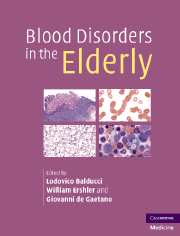Book contents
- Frontmatter
- Contents
- List of contributors
- Preface
- Part I Epidemiology
- Part II Hematopoiesis
- Part III Anemia of aging
- 12 Erythropoietin and aging
- 13 Iron and aging
- 14 Prevalence and mechanisms of B12 deficiency
- 15 Consequences of chronic anemia in the older person
- 16 The pathogenesis of late-life anemia
- 17 Treatment of late-life anemia
- Part IV Hematologic malignancies and aging
- Part V Disorders of hemostasis in the elderly
- Index
12 - Erythropoietin and aging
from Part III - Anemia of aging
Published online by Cambridge University Press: 21 October 2009
- Frontmatter
- Contents
- List of contributors
- Preface
- Part I Epidemiology
- Part II Hematopoiesis
- Part III Anemia of aging
- 12 Erythropoietin and aging
- 13 Iron and aging
- 14 Prevalence and mechanisms of B12 deficiency
- 15 Consequences of chronic anemia in the older person
- 16 The pathogenesis of late-life anemia
- 17 Treatment of late-life anemia
- Part IV Hematologic malignancies and aging
- Part V Disorders of hemostasis in the elderly
- Index
Summary
Introduction
Anemia represents a common problem among the elderly, with a prevalence of 5–10% for the community-dwelling elderly between 65 and 74 years, and over 20% for seniors 85 years and over. In hospitalized elderly patients and in skilled nursing facilities, anemia prevalence ranges from 40 to 50%. The recent appreciation of the numerous adverse consequences of anemia has generated interest in a more complete understanding of anemia in the elderly. Erythropoietin (EPO) is a hormone central to the regulation of red-blood-cell production that increases in response to falling hemoglobin concentration. Paradoxically, although EPO levels rise slightly with age in non-anemic elderly people, the expected EPO response to anemia appears significantly blunted in the elderly, supporting a relative endogenous EPO deficiency. This relative EPO deficiency, possibly attributable to occult renal insufficiency, may play a central role in the rising prevalence of anemia with advancing age and unexplained anemia in the elderly.
Erythropoiesis
Hematopoiesis, the production of blood elements, occurs in an orderly hierarchical fashion. Maintenance of mature peripheral blood cells (i.e., platelets, red blood cells or erythrocytes, neutrophils, eosinophils, basophils, monocytes, lymphocytes, natural killer cells, and dendritic cells) demands ongoing production to meet losses and respond to stresses. A pluripotent hematopoietic stem cell produces committed progenitors of myeloid, erythroid, and megakaryocytic lineages.
- Type
- Chapter
- Information
- Blood Disorders in the Elderly , pp. 157 - 170Publisher: Cambridge University PressPrint publication year: 2007



